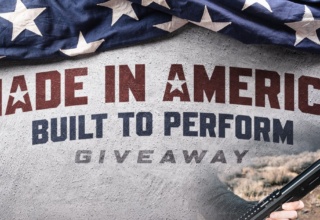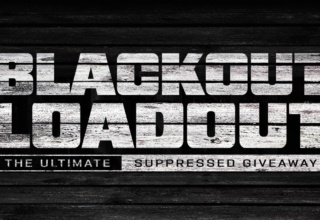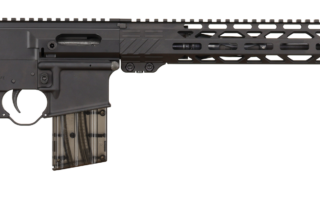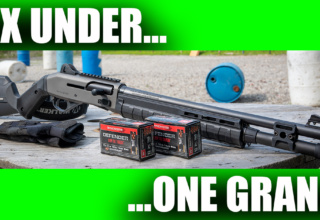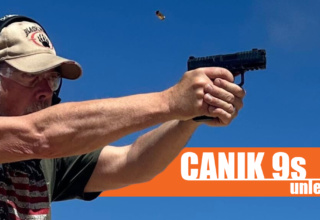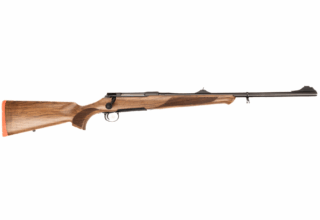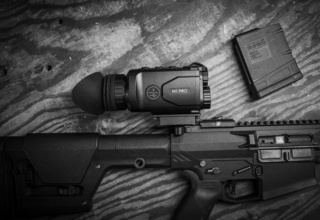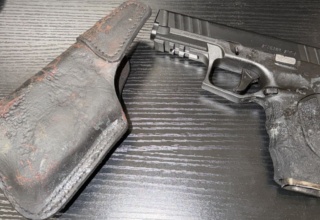When the current crop of “AR pistols” came on the scene, I must admit that I fell squarely in the “Oh, good grief” camp. This was before innovative folks cooked up the concept of arm braces to skirt around the whole SBR thing. Thus, all the AR pistols that came within my orbit sported bare receiver extension tubes. Yeah, might be fine for some gun fans, but in rifle caliber…not for me.
Then came the workarounds, like the pistol braces from Sig and SB Tactical. Way cool. This was followed by the ATF saying, “good to go,” and then “maybe not so good to go if you want to shoulder,” to the current “maybe or maybe not good to go; sounds like good to go, but…”
Whatever the case may be, I have certainly come around to the AR pistol—at least in pistol-caliber chambering.
Short rifles have always fascinated me, particularly tactical SBRs. Perhaps it’s my prepper inclinations guiding my thought process, but the concept of a short, backpack-totable, behind-the-truck seat stuffable, get-back-home through civil chaos defensive rifle is solid in my way of thinking. While I favor my 300-yard tack-driver AR, it’s not exactly light on its feet, nor is it my reach-for gun at 3 a.m. (a shotgun and several handguns will take care of that). And while many will argue that a .223/5.56 is ideal for home defense, it wouldn’t be my choice if I lived in the city or the suburbs.
A 9mm AR pistol, on the other hand, has a whole lot going for it.
First, there is the ammo compatibility with my EDC pistol and my front-door-answering pistol. I can run the same ammo in all guns without a hitch, so a session at the handloading bench stocks me up for defensive rounds without having to change dies and powders and all that fun.
For training and recreational target shooting, I can buy 9mm bulk ammo and save money not only from the quantity discount, but also because 9mm comes a lot cheaper than 5.56.

Next, my theoretical argument for a 9mm AR pistol in the event of a societal meltdown while I am on the road lends itself to this platform. Let’s be realistic—in this scenario, it’s going to be all about short-range engagement. A 16-inch barrel AR would do well for clearing a path home, but I believe the short pistol-length AR would hold the overall advantage if defending yourself from a vehicle or if you must trek on foot.
The other advantage comes from the aforementioned ammo cross-compatibility. A 9mm handgun is on my person regardless. Having an AR pistol (with its longer engagement-distance potential and accuracy) that uses the same ammo means I only need one cartridge type for both.
Oh, and should this theoretical bug-home situation ever come down, you can bet that the pistol stabilizing brace on my AR pistol will serve me well. The last thing I’ll be concerned with at that point is whether the ATF crew has an issue with me shouldering my pistol or not. Know what I mean?
Recently, we had a chance to spend some quality time with a new 9mm AR-platform pistol that precisely meets all our requirements for a “bad times are here”/home-defense firearm. Let’s just say our boots are now solidly rooted in the AR pistol camp.
Earlier this year, the folks at Rock River Arms introduced a new series of ARs called the BT-9. As the name implies, the BT-9 is chambered for 9x19mm Luger. Included in the series is one rifle and two pistols. The rifle comes with a 16-inch barrel. The pistols are offered with 7- and 10.5-inch barrels. In addition to their 9mm chambering, all feature a GLOCK-compatible lower receiver, making them compatible for use with GLOCK mags or similarly manufactured aftermarket mags.

As you would expect, the BT-9 lower is machined from billet aluminum, with a mag well designed specifically to accept GLOCK 9mm magazines. Our G17’s mags slipped right in and worked flawlessly. Of course, this means you can vary your ammo capacity based on the number of rounds your magazine holds. Here is where those high-capacity GLOCK mags start to make sense.
Another thing the RRA BT-9 lower has going for it is the trigger guard. It’s integrated into the lower and over-sized (compared to standard AR trigger guards), placing it into the winter trigger guard column, so it is easy to shoot when wearing gloves. The magazine release lever has a large, serrated tab you push to drop the mag. It’s not as prominent as a standard AR mag release button, but it presented no problems in our testing.
The upper receiver is an extruded aluminum unit that blends almost seamlessly with RRA’s Lightweight Aluminum Free-Float hand guard. This hand guard/receiver design first appeared in last year’s RRAGE 5.56 rifle model by RRA, and it seems as if this approach is filtering into many of their new models. We like it a lot because it presents a clean look and smooth-handling profile akin to a monolithic upper assembly. The top of the hand guard has a Picatinny rail across the full length. This is great for a pistol configuration because you can install backup open sights or put your red dot optic somewhere over the hand guard if that works best for you. Being M-LOK compatible, you can easily add a tactical light or laser, if you so choose.

Aside from the barrel/hand guard lengths, the only other difference between the 7-inch and 10.5-inch BT-9 pistols is the grip. The 7-inch model comes with RRA’s NSP overmolded grip; the 10.5-inch sports a Hogue rubber grip. We much prefer the Hogue because the widening profile (toward the grip base) and the ergonomic finger grooves combine to deliver a more comfortable, no-slip purchase and greater muzzle control when shooting the firearm in two-hand pistol fashion or one-handed with the stabilizing brace.
Speaking of the stabilizing brace, the BT-9 comes with the SBA3 model manufactured by SB Tactical. It is designed to allow you to insert your forearm into it and cinch it in place with a hook-and-loop strap while your shooting hand wraps around the pistol grip. Does it work in this configuration? Yes, if you can get it secured to your forearm. I don’t have the thickest forearms and there was barely enough strap for me to secure it in place, should that be the way I wanted to shoot the pistol. I found shooting this way to be awkward and fatiguing in short order. I had better luck keeping my arm out of the brace and adjusting the length-of-pull (there are five positions) to use the brace as a support on the inside of my arm. By holding the pistol in this manner, I could grasp the hand guard and shoot rather comfortably by tilting the pistol slightly.

There are other hold methods you can experiment with when using the SBA3 brace. Optimal, of course, is to extend the length-of-pull and place it to your shoulder. As of this writing, the current understanding of the BATFE’s position on this, according to a letter written to SB Tactical counsel Mark Barnes on March 21, 2017, “clarifies” the BATFE’s Open Letter statement of 2015 regarding the act of shouldering a pistol with an approved stabilizing brace. The new opinion, based on the Barnes letter, seems to suggest that shouldering a pistol-length AR equipped with a BATFE-approved stabilizing brace does not instantly create an NFA firearm (which is what the Open Letter of 2015 seemed to imply). The critical statement from BATFE Assistant Director, Enforcement Programs and Services Marvin G. Richardson in his letter to Barnes states:
“To the extent the January 2015 Open Letter implied or has been construed to hold that incidental, sporadic, or situational “use” of an arm-brace (in its original approved configuration) equipped firearm from a firing position at or near the shoulder was sufficient to constitute ‘redesign,’ such interpretations are incorrect and not consistent with ATF’s interpretation of the statute or the manner in which it has historically been enforced.”
So, it would seem that shooting the RRA BT-9 pistol in any manner that is suitable for the situation is A-OK as long as the stabilizing brace is in no way altered from its original design specifications or intent—at least to our non-professional layman interpretation. You would have to make your own decision in this matter and weigh it against prevailing laws in your state or area. We certainly won’t be worrying about it should we be required to use it this way in a defensive situation.

We had boxes and boxes of 9mm on hand for our test day shoot and are pleased to report that the BT-9 ran flawlessly, shooting both bulk round-nose ammo and handloaded defensive loads. We started on the bench to get our TRUGLO TRU-TEC red dot dialed in before moving onto various shooting positions and exercises. The felt recoil is pretty much nothing with the BT-9’s blowback bolt system. Ditto for muzzle rise (more than a .22LR, less than a 5.56). At 25 yards, shooting with the TRU-TEC’s 3MOA dot (not the best option for establishing group potential, of course!), we managed a best five-shot group of 1.16 inches. For close-quarter engagement, we’ll take that every day. It will be interesting to see what the 50- and 100-yard groups will turn in when we add a scope.

Understandably, this isn’t the kind of gun you want to saddle with a magnified optic. Others may have differing opinions, but from our worldview, the BT-9 is all about having an optimal close-quarter defense firearm—one that transports easy, handles well in tight quarters, and provides ammunition and magazine compatibility with our primary EDC and bedside handguns. In that, Rock River Arms’ newest entry in the pistol-caliber lineup hits all the right buttons.
RRA BT-9 10.5-Inch Pistol Specifications
Caliber: 9x19mm
Lower Receiver: BT-9 billet aluminum w/GLOCK-compatible flared mag well and integral winter trigger guard
Upper Receiver: extruded aluminum A4
Barrel: chrome moly, 1:10 twist
Barrel Length: 10.5 inches
Muzzle Device: A2 flash hider, 1/2-36 thread
Trigger: RRA two-stage
Handguard: RRA Lightweight Aluminum Free-Float, 9.25-inch mid-length, M-LOK compatible
Arm Brace: SB Tactical SBA3 Stabilizing Arm Brace, 5-position adjustable
Grip: Hogue rubber grip
Weight: 6 pounds
Length: 29.5 inches (extended)
Includes: one GLOCK-compatible magazine, manual, warranty
MSRP: $1,285.00


